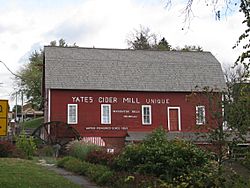Yates Cider Mill facts for kids
 |
|
| Location | Rochester, Michigan and Shelby Charter TWP |
|---|---|
| Owner | Mike and Katie Titus |
| Construction | |
| Completed | 1863 |
Yates Cider Mill is a famous cider mill located in Rochester, Michigan. It has a long history, starting in 1863 as Yates Grist Mill, which was used to grind grain. To power the mill, the Yates Dam was built, using the force of water. In 1876, the mill changed its name to Yates Cider Mill. This happened when a cider press was added to the water-powered system. Since then, the mill has been making fresh apple cider. Local farmers and orchard owners used to bring their apples here to be pressed into cider.
Contents
How Water Powers the Mill
Today, when you visit Yates Cider Mill, you can still watch cider being made. It's powered by a special machine called a turbine. This turbine was first put in place way back in 1894, and it's still the original one used today! Recently, the turbine was carefully removed, cleaned, and put back. This helps keep the mill's history alive and continues the old tradition of making cider. Water from the dam travels through a large underground pipe to the mill. This water then spins the turbine, making the whole cider-making process work.
Making Delicious Apple Cider
Yates cider is made without any extra preservatives. They mix as many as six different kinds of apples to get the perfect taste.
Getting the Apples Ready
The process starts when apples arrive from Michigan orchards. They come in huge boxes, each weighing about 1000 pounds! A forklift unloads these heavy boxes. The apples are then moved to a special area where they are cleaned and checked. Any apples not needed right away are kept cool in storage at the mill.
Grinding and Pressing the Apples
The apples that are ready to be used are cleaned and then lifted by an elevator. They drop into a large, cone-shaped container called a hopper, which can hold a lot of apples. This hopper is on the second floor of the mill. Down on the first floor, the rest of the cider-making magic happens.
A handle on the first floor controls a door at the bottom of the hopper. This door opens, letting the apples fall down a chute. As they go down, the apples are chopped into small pieces. These chopped apples are then put into special nylon blankets. This is repeated until about 12 blankets are stacked on top of each other.
Squeezing the Cider Out
The stacked layers of chopped apples are placed on a big spinning table. This table moves under the apple press. The press at Yates Cider Mill is called a 'screw press'. It uses large screws that turn to push the press down. This puts a huge amount of pressure, about 50 tons, on the blankets of chopped apples for 15 minutes! As the press squeezes, the fresh cider comes out through the fabric of the blankets. The seeds, apple peels, and pulp stay inside the blankets.
Finishing the Cider
After the cider is squeezed out, the leftover apple parts are dropped down a chute into a small rail car under the mill. This car is then taken to a dump area. The fresh cider flows from the press into cold mixing tanks. From there, the cider is filtered to remove any tiny apple pieces. The very last step is UV treatment, which makes sure the cider is safe to drink before it's bottled. During a busy autumn weekend, the mill can press over half a million apples. They can make an amazing 300 gallons of cider every hour!
Yates Cider Mill in the Media
In October 2009, Yates Cider Mill was shown on the Food Network TV show, Unwrapped. It was part of a special episode called "Fall Favorites," which showed how things are made behind the scenes.
Images for kids



